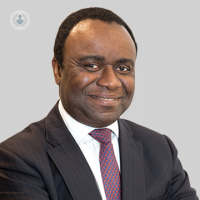Treatment of early onset scoliosis: what is the MAGEC system?
Written by:Early onset scoliosis is a type of scoliosis which develops in children before the age of 10. The term ‘scoliosis’ refers to a curvature of the spine, which often results in an S-shaped, or C-shaped curve. Scoliosis most commonly affects adolescents (in the 10-15 age gap), but it can occur earlier, with both early onset and adult scoliosis overall affecting an estimated 3% of people. Mr Colin Nnadi, expert spinal surgeon specialised in paediatric spinal conditions, explains more about the condition and some of the newer methods it can be treated with.

What is early onset scoliosis?
Scoliosis occurs when the spine curves in an abnormal manner, which usually looks like the letter S or the letter C in shape. This curve is not a disease, but rather is a condition, which can happen at any age. Early onset scoliosis can happen at any time between birth and the age of ten. Scoliosis can sometimes be visible, as it occasionally causes a lump to form on the back as a result of the spinal twisting, moving the ribcage out of place. The curve can vary in size, and can develop over time.
What causes early onset scoliosis?
Early onset scoliosis is usually idiopathic, which means it has no known cause. However, in some cases the scoliosis develops in the womb, as bones develop abnormally, or bones are abnormal in size. In cases like this, the scoliosis is called congenital scoliosis.
What are the symptoms of early onset scoliosis?
When watching your child, some movements such as tending to lean to one side in particular can be an indication of EOS. Some other common signs include one of the shoulder blades being more apparent and sticking out more than the other, clothes not fitting properly, an uneven waist, or uneven hips. If a child with scoliosis bends forward, sometimes the curve in the spine becomes more apparent, and there may be a bulge where the ribs stick out. If these symptoms present, visit your GP who can examine the back and refer your child to a specialist if necessary. It is very unlikely for there to be something seriously wrong, but with early onset scoliosis, the earlier the child is treated, the better, as in many cases the spinal curve can be moved, shaped or guided to grow straighter.
How is early onset scoliosis treated?
EOS can be treated in various ways, often starting with observation and monitoring, which will check if the scoliosis develops or worsens in any way. This means your child will be required to attend check-ups, and have X-rays taken. If the scoliosis is the same, and does not worsen in any way, it may not need treatment until your child is fully grown. In very young children, the curve sometimes corrects by itself, but it is still important for your child to be monitored.
If treatment is indeed necessary, there are various methods which can be employed:
A cast or brace
The spine can be guided into position by using a brace or cast. Casts cover the top half of the body, and are fitted to the child, being changed at regular periods as they grow. The cast is made of light material, but tasks such as changing nappies and bathing can be difficult to get used to at first. One advantage of a cast is that as it is not removable, it does not have to be put on and taken off daily.
Another option to help the spine’s growth and reduce the size of the curve is the use of a brace. Braces are removable, but they are worn for 23 hours a day. They fit under the clothes, but they can be taken off during bath time, or during sports activities.
Surgery
If casts or braces do not stop the curve’s progression, or the curve does not look as if it can be corrected using these methods, surgery may become an option. Spinal surgery in young children attempts to correct the spine without hindering the child’s growth in any way. There are various methods of surgery available, including growing rods, spinal fusion and growth guided devices. The surgeon will assess what is best for your child and explain what the surgery entails. Whilst spinal surgery is indeed an invasive procedure, new techniques and approaches are helping to reduce tissue trauma, and lower the risk of surgical complications.
An innovative approach: MAGEC rods
In some cases, surgery involves the insertion of growth rods into the spine, which help to lengthen the spine as the child grows. However, new approaches to the treatment of scoliosis mean that this can now be done non-invasively, allowing the child to grow but eliminating the need for repeated surgical procedures.
MAGEC uses a titanium growth rod, which is implanted and fixed into the body, helping to brace the spine and allow it to grow and lengthen. MAGEC rods contain a magnet, which allows the rod to be adjusted from outside the body. This magnet is manipulated using an external remote controller (ERC), which the doctor places over the spine. The ERC causes magnets in the rod to rotate, thus allowing them to move the rod and lengthen or shorten it as necessary.
This is a novel approach which minimises the need for surgery – the lengthening or shortening procedures are done as outpatient procedures, meaning your child can visit the clinic and be home in the same day, much like a normal doctor’s appointment. The visit is quick and generally painless, meaning your child can return to normal activity and not miss out on school time, time with family, or many other important things which could be hindered by repeat surgical operations.
New approaches mean surgeons have many more options when deciding on the best course of action in the treatment of early onset scoliosis. While scoliosis may seem worrying, and scary at times, treatment options, surgical techniques, and innovative systems like the MAGEC rods are highly successful and allow more than adequate management, or correction, of your child’s spinal curve.


